Abstract
In order to effectively respond to floods and water emergencies that result in the drowning of missing persons, timely and effective search and rescue is a very critical step in underwater rescue. Due to the complex underwater environment and low visibility, unmanned underwater vehicles (UUVs) with sonar are more efficient than traditional manual search and rescue methods to conduct active searches using deep learning algorithms. In this paper, we constructed a sound-based rescue target dataset that encompasses both the source and target domains using deep transfer learning techniques. For the underwater acoustic rescue target detection of small targets, which lack image feature accuracy, this paper proposes a two-branch convolution module and improves the YOLOv5s algorithm model to design an acoustic rescue small target detection algorithm model. For an underwater rescue target dataset based on acoustic images with a small sample acoustic dataset, a direct fine-tuning using optical image pre-training lacks cross-domain adaptability due to the different statistical properties of optical and acoustic images. This paper therefore proposes a heterogeneous information hierarchical migration learning method. For the false detection of acoustic rescue targets in a complex underwater background, the network layer is frozen during the hierarchical migration of heterogeneous information to improve the detection accuracy. In addition, in order to be more applicable to the embedded devices carried by underwater UAVs, an underwater acoustic rescue target detection algorithm based on ShuffleNetv2 is proposed to improve the two-branch convolutional module and the backbone network of YOLOv5s algorithm, and to create a lightweight model based on hierarchical migration of heterogeneous information. Through extensive comparative experiments conducted on various acoustic images, we have thoroughly validated the feasibility and effectiveness of our method. Our approach has demonstrated state-of-the-art performance in underwater search and rescue target detection tasks.
1. Introduction
With the robust advancement of water transportation, marine resource exploitation, offshore operations, and the underwater entertainment industry, the frequency of accidents has also increased significantly, often resulting from natural disasters like floods and tsunamis. Consequently, the urgent need for rapid underwater rescue operations has become paramount. However, underwater search and rescue missions are inherently challenging and hazardous. Autonomous Underwater Vehicles (AUVs) offer a promising alternative to effectively carry out the search and positioning of underwater rescue targets.
The primary detection methods employed by underwater AUVs are optical and acoustic. However, given that light is significantly attenuated underwater, optical detection is primarily suitable for use within a limited underwater range [1]. Currently, sonar technology has demonstrated effective results in fish searches, wreck detection, underwater geomorphology mapping, and underwater mineral exploration [2]. Nevertheless, its detection capability for weaker targets, such as missing persons, remains inadequate. Furthermore, the scarcity of authentic underwater acoustic rescue target datasets poses a considerable challenge in training machine learning-based detection methods.
In order to make AUVs improve the accuracy of rescue target recognition, this paper targets acoustic rescue small sample training as well as small weak acoustic rescue targets. Due to the scarcity of real underwater acoustic rescue target datasets, this poses a greater challenge to model training. Migration learning [3] has long been applied in machine learning methods in different fields and can effectively alleviate the pressure of a lack of datasets. Valdenegro-Toro M. et al. [4] studied and analyzed migration learning, finding that it can effectively improve model recognition when there is a lack of sonar image datasets. Mckay J. et al. [5] conducted a research study related to the automatic detection of acoustic images of mine-like objects, and in order to solve the problem of the lack of acoustic image datasets, the use of migration learning methods, and the combination of Convolutional Neural Networks (CNN) and Support Vector Machine (SVM), was proposed. Ye et al. [6] attempted to classify underwater targets in side-scan sonar images using pre-trained VGG11 and ResNet18 and proposed a training sample pre-processing method with better implications for the migration learning effect. The transformation from low-complexity tracking raymaps to real sonar images is learned by training GAN (Generative Adversarial Networks) to randomly generate sample data with a consistent distribution of the training dataset [7,8,9,10,11,12,13,14]. Zhang Wenwu et al. [14] used a GAN model and a CycleGAN model to produce sonar images directly from noisy data in order to expand the acoustic image dataset, and the generated results were not good due to poor image data. Huo et al. [15] proposed a semi-synthetic data method mainly for extracting target contours of optical images of ships and aircraft, using a Weibull probability distribution function for the sonar images of Barngrover et al. [11], who preprocessed the optical images and combined them with sonar image features to generate mine-like semisynthetic training data to augment the data set. The complex characteristics of sonar images, such as blurred edges, strong noise, and diverse target shapes, make the data difficult to process, and the above is mainly for objects that are large and distinguishable from their contours and surroundings, such as wrecks, crashed aircraft, and mines. The generation of semi-synthetic pseudo-data is performed, which is not only tedious in the generation process, but also not ideal for improving the detection of drowning victims for underwater rescue targets in real environments. Cheng et al. [16] proposed a multi-domain collaborative migration learning for side-scan sonar images of sunken ships and wrecked aircraft in response to the shortcomings of semi-synthetic data and the inability of pre-trained models based on large optical datasets to match sonar image feature classification, which mainly considers convolutional layers near the input layer to improve the ability to extract low-level edge features from the noisy background of targets in sonar images, which usually have noise-statistical features similar to synthetic aperture radar (SAR) images. Several fully connected layers near the output layer enhance the ability to map high-level feature vectors to the semantic space of sample classes, and optical images with a similar shape as the same target class as sonar features. Chen et al. [17] embedded a multi-head self-attention mechanism into the acoustic target detection network, and captured poor acoustic target features by establishing a global dependency to improve the accuracy of target detection. Li et al. [18] proposed a transformer feature fusion network based on the transformer stack structure to promote information fusion. Moreover, they also propose a novel method called ellipse quality evaluation to improve the reliability of the localization quality estimation, and reduced the false detection rate caused by low resolution. The sonar images of drowning people targeted in this paper are not as clearly distinguished from the target shapes of shipwrecks and wrecked aircraft sonar images, as well as from the surrounding environment, so the mere consideration of high-level shape features is not applicable to drowning people sonar image target recognition.
Underwater acoustic rescue target detection is small target detection, and small targets do not have richer image features like medium and large targets, and the image features of small targets are more difficult to be fully extracted by the network model, so small target detection is vulnerable to interference from noise, background, etc., which makes the network model unable to accurately detect and locate small targets [19]. To solve the problem of the poor performance of small target detection in underwater sonar images, Wang et al. [20] constructed a multi-branch shuttle network and embedded it into YOLOv5s, and replaced the neck of YOLOv5s with BiFPN to detect and identify small targets such as plastic bags, fishing nets, and clothes in sonar images, and verified that the deeper network in the YOLOv5 family is not suitable for the small and weak targets designed in this experiment. However, the method requires a high sonar image background, and the recognition results are often unsatisfactory if the image background is complex and there are more interferences. Yu et al. [21] found that the scale mismatch between the target size of the dataset used for pre-training and the target size of the dataset used for target detection through the detection and recognition experiments on the Tinyperson small target human dataset causes feature representation and detector performance degradation. However, due to the complex background environment of real underwater acoustic images, the scale mismatch between the dataset used for migration training and the dataset used for detector learning can cause false detection of the surroundings of underwater acoustic images if only the scale mismatch between the dataset used for migration training and the dataset used for detector learning is considered.
To effectively tackle the challenges in underwater search and rescue target detection tasks and achieve the visual and auditory detection, recognition, and localization of submerged missing persons, this paper makes the following primary contributions:
- An automatic underwater acoustic rescue target detection method combining hetero-geneous information hierarchical migration learning for the lack of a underwater acoustic rescue target dataset and a two-way branching convolution module for un-derwater acoustic rescue targets as small targets is proposed. The heterogeneous hierarchical migration learning method utilizes the SAR dataset as well as the optical small target human dataset on land with cross-similar features to the underwater acoustic rescue target dataset for hierarchical migration.
- The YOLOv5s network model is improved in combination with the ShuffleNetv2 [22,23,24,25] network module to make the method more applicable to underwater unmanned robotic embedded devices for underwater acoustic rescue target detection. The code will be available at https://github.com/Tao-GCPD/Underwater-rescue-target-detection-based-on-acoustic-image (accessed on 8 February 2024).
2. Materials and Methods
2.1. Lightweight Underwater Acoustic Rescue Target Detection Algorithm
To reduce the storage requirements and improve the detection speed of YOLOV5s on embedded AUV devices, this paper introduces a novel approach. It utilizes a double branch convolutional network module (DbConv) based on the residual network module [26], widening convolutional layers to enhance feature extraction and improve detection accuracy for small acoustic targets while minimizing model parameters. Additionally, the ShuffleNetv2 network module is integrated into YOLOv5s, effectively preserving the detection accuracy for weak targets in acoustic images while significantly reducing computational requirements.
2.1.1. Db-YOLOv5s Architecture and Db-ShuffleNetv2-YOLOv5s Architecture
We have modified the YOLOv5s backbone network with ShuffleNetv2 and DbConv modules, as depicted in Figure 1, which includes ShuffleNetV2_1, ShuffleNetV2_2, and SPPF. ShuffleNetV2_1 omits downsampling (Figure 1, while ShuffleNetV2_2 incorporates downsampling (Figure 1). In place of the original YOLOv5s layer 0 network, we have integrated the DbConv module, and for detecting acoustic small targets, we have replaced the backbone network with a combined downsampling module from ShuffleNetV2_1 and ShuffleNetV2_2. This reduces the depth of the backbone network, changing the location of network layers for feature fusion with the Neck network. Specifically, we now perform feature fusion with the layer 2 and layer 4 network image features of the backbone network, making the fusion process shallower.
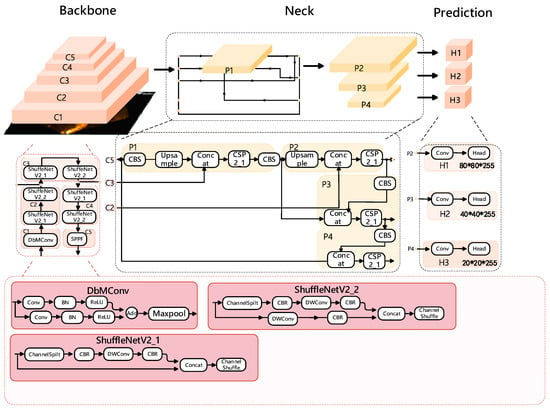
Figure 1.
ShuffleNetv2-Db-YOLOv5 s network model structure.
2.1.2. Double Branch YOLOv5
The method we designed achieves a balance between model lightweighting and accuracy by minimizing the network depth as much as possible. The double branch convolution (DbConv) module, designed for YOLOv5s, is depicted in Figure 1. In Figure 1, the double branch convolution module splits the input feature map into two equally sized branches along the channel dimension. Each branch undergoes the same operations, starting with a 1 × 1 convolution, followed by batch normalization (BatchNorm), ReLU activation, and, finally, their feature maps are merged using addition. This module is primarily intended for small object detection in acoustic rescue scenarios with YOLOv5. It replaces the CBS module in the 0th layer of the YOLOv5s model with smaller convolution kernels, resulting in a model called Db-YOLOv5s.
2.1.3. ShuffleNetv2 Network Module
While large CNN networks have significantly improved image detection and recognition accuracy, in certain specialized scenarios, large and complex models can slow down detection speed, particularly in resource-constrained scenarios such as underwater unmanned vehicles with limited storage and computational resources and high real-time requirements. To address these challenges, lightweight CNN networks like MobileNet and ShuffleNet have been introduced to strike a balance between real-time performance and accuracy.
ShuffleNetv2 [24], proposed by Kuangwei Technology, outperforms ShuffleNet and MobileNetv2 in terms of accuracy. In Figure 1, to alleviate the burden on the YOLOv5s model, we designed double branch convolution modules customized for ShuffleNetv2. It also splits the input feature map into two equally sized branches along the channel dimension. Both branches undergo a 3 × 3 convolution with a stride of 2, followed by batch normalization, ReLU activation, and, finally, their feature maps are merged. The core operation in ShuffleNetv2 is the channel shuffle, which facilitates information exchange between branches.
2.2. Heterogeneous Information Hierarchical Transfer Learning
To enhance the detection of underwater acoustic rescue targets, extensive training data is essential. However, our experiment uses a limited underwater rescue target acoustic image dataset, which lacks real underwater images and pertains to small targets. Using only a model-based migration approach, with the optical human dataset from land as the source domain for pre-training and the underwater rescue target acoustic image dataset for fine-tuning, lacks adaptability across domains due to differing statistical properties between optical and acoustic images. Consequently, the trained network becomes overly sensitive to source domain features and struggles with feature extraction in the target domain. To overcome these issues, this paper employs cross-domain similarity features for migration learning, enhancing model training and enabling improved detection performance.
Both the small optical dataset and the acoustic dataset share high-level semantic features such as shape and contour, and their target sizes match. For our small-sample acoustic data, we propose a heterogeneous hierarchical transfer learning method based on model migration. We use the heterogeneous hierarchical migration learning method to train the ShuffleNetv2-Db-YOLOv5 model, as illustrated in Figure 2. Initially, we train the SAR dataset and the optical human dataset separately on the Db-YOLOv5s model, saving the trained weight files. We then extract the trained weights from layer 0 in the SAR dataset weight file and migrate them to the corresponding target ShuffleNetv2-Db-YOLOv5 network model for retraining in the target domain. Similarly, we extract and migrate weights from layer 1 to layer 24 from the trained weight file of the optical human dataset to the target Db-YOLOv5s network model for retraining on the target position image dataset.

Figure 2.
Heterogeneous hierarchical migration learning based on YOLOv5s-DbConv.
When simulating real rescue scenarios, detecting underwater rescue targets acoustically can be challenging due to the complex background in Figure 3. This background includes floating docks, small boats, underwater noise, and other objects, leading to false detections. In the magnified detection results, the green rectangle represents correct detections by the algorithm, while the red rectangle indicates erroneous detections. These errors often occur when strong reflections from dot-like and bar-like objects in the complex underwater background interfere with the detection of underwater acoustic rescue targets.
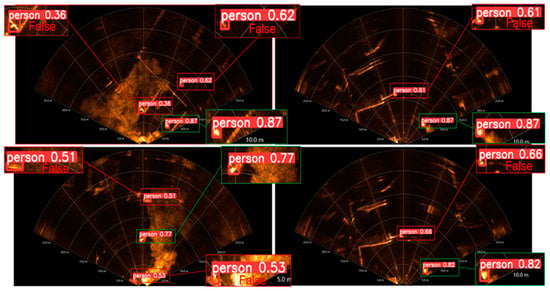
Figure 3.
Outdoor complex background underwater rescue target acoustic image detection effect.
3. Results
3.1. Data Set Used
In this paper, the acoustic image-based underwater rescue target image data was acquired in the Qingdao outdoor development sea dock and the Harbin Engineering University comprehensive experimental pool, the experimental equipment was BlueView M900-130 multi-beam imaging sonar, and the multi-beam imaging sonar-related parameters are shown in Table 1.

Table 1.
M900-130 multi-beam imaging sonar parameters table.
Figure 4a shows a schematic diagram of the acoustic image data acquisition for underwater rescue targets. Figure 4b displays the experiment conducted in the Harbin Engineering University’s comprehensive pool, measuring 50 m in length, 30 m in width, and 10 m in depth. To enable comparative experiments on small target recognition, car tires filled with weights are placed in the pool for filming. Recognizing that the real underwater environment is more complex, with added foreign objects and noise, we conducted data image acquisition in the Qingdao open sea wharf, as shown in Figure 4c. Divers, equipped with diving gear, mimic drowning scenarios in designated areas, capturing underwater rescue target acoustic images. We filmed various sea areas around the wharf, capturing outdoor underwater rescue target acoustic images. Examples of the acquired images is shown in Figure 5. These images are influenced more significantly by their surrounding environment compared to the pool’s underwater rescue target acoustic images.
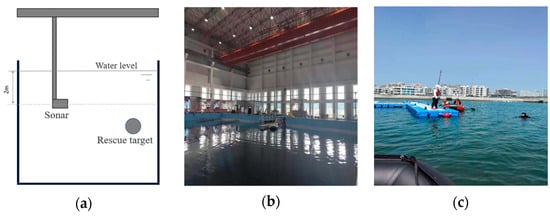
Figure 4.
(a) Schematic diagram of acoustic image data acquisition for underwater rescue targets, (b) The comprehensive experimental pool, and (c) Qingdao open sea terminal.

Figure 5.
(a) Acoustic image of the pool underwater rescue target. (b) Acoustic image of outdoor underwater rescue target.
The target domain is the underwater rescue target acoustic image dataset, where the training set and test set are divided as shown in Table 2. The purpose of this division is due to the outdoor underwater rescue target acoustic images having a more complex background and noise, being more difficult to detect, and more in line with the real rescue environment, compared to the pool underwater rescue target acoustic images. The training set having a smaller proportion of outdoor underwater rescue target acoustic images and the test set having a larger proportion of outdoor underwater rescue target acoustic images ensure the generalization of the method used in the experiment.

Table 2.
Training set and test set division of the target domain data set.
The source domain data required for the heterogeneous information hierarchical migration learning method used in this experiment are the SAR (Synthetic Aperture Radar) dataset, as shown in Figure 6, and the small target human optical image dataset, as shown in Figure 6a,c, The source is divided into data sets as shown in Table 3.
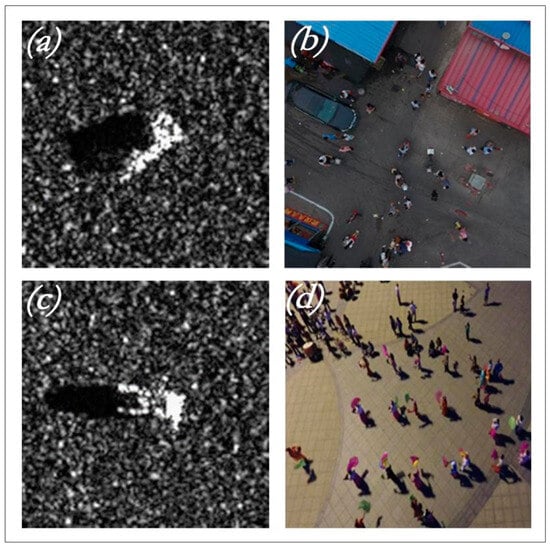
Figure 6.
SAR data set and optical human dataset. (a,c) are the SAR dataset samples. (b,d) are the optical human dataset samples.

Table 3.
Training set and test set division of the source domain dataset.
The SAR dataset is derived from the MSTAR program, providing ground-based stationary target data obtained by a high-resolution spot-beam synthetic aperture radar (SAR) sensor with a 0.3 m × 0.3 m subscale. It primarily contains SAR sliced images of stationary vehicles captured at various azimuth angles.
The optical human dataset (Figure 6b,d) on land is constructed from images within the VisDrone2019 dataset, collected by Tianjin University’s AISKYEYE team. This extensive dataset includes over 2.6 million manually annotated frames of common targets like pedestrians, cars, bicycles, and tricycles. The optical human dataset used in this paper specifically comprises pedestrian data from this source.
3.2. Evaluation Indicators
In this paper, the evaluation metrics for the detection of underwater acoustic rescue targets are mainly the mean average precision (mAP), as well as the computational volume of forward inference (GFLOPs) and the number of parameters.
TP represents correctly identified actual targets with correct predictions, while FP denotes incorrect actual targets detected as correct. TN indicates correct actual targets not detected, and FN represents incorrect actual targets not detected. Detection is considered correct (TP) if the intersection ratio of the true frame and the predicted frame exceeds the set threshold; conversely, it is deemed incorrect (FN) if it falls below the threshold.
The accuracy rate, as defined by Formula (1), quantifies the ratio of correctly detected targets (TP) to the total targets detected as correct. Notably, a higher number of correctly identified actual targets leads to a higher accuracy rate when a certain number of samples yield correct predictions.
The recall rate, expressed in Formula (2), quantifies the ratio of correctly detected targets (TP) to the total actual targets detected. When the number of samples correctly identifying actual targets remains constant, a larger number of samples correctly predicted as targets results in a higher recall rate. This implies that a higher recall rate indicates fewer missed correct targets in the network model’s predictions, ultimately yielding more accurate results.
3.3. Experimental Environment
The following is the host environment information used in the experiments: the operating system was Ubuntu 18.04, the programming language was Python 3.7, the GPU model was Nvidia RTX 3090 produced by Nvidia, Santa Clara, CA, USA, and the deep learning framework was PyTorch 1.8.1. To accelerate the training of neural network models, we also installed CUDA and CuDNN. More detailed environmental information is provided in Table 4.

Table 4.
Experimental environment configuration.
3.4. Performance Analysis
In this paper, we experimented with the Db-YOLOv5s model, freezing different combinations of network module weight parameters; namely, layer 0, layers 0 and 1, layers 0 to 3, and layers 1 to 3. The results are summarized in Table 5. Comparing the outcomes to not freezing any network module weight parameters, we observed that freezing layer 0 and layers 1 to 3 enhanced the model’s mAP for underwater rescue acoustic target detection. Notably, freezing layer 0 provided the most significant improvement, raising the mAP by 0.013 compared to not freezing any layer. This improvement is attributed to the freezing of weight parameters for both the SAR dataset training migration and the optical small-target human dataset migration, which subsequently preserves and reinforces cross-similarity between datasets. Fine-tuning the remaining unfrozen layers with the underwater rescue target acoustic image dataset further enhances detection accuracy. This underscores the feasibility of the proposed heterogeneous information hierarchical migration learning principle.

Table 5.
Comparison of the effects of different methods.
We used a training strategy that involved pre-training an acoustic image dataset with an optical image dataset to compare Db-YOLOv5s, our improved small target detection algorithm, with the standard YOLOv5s algorithm. Then, we introduced a proposed heterogeneous information hierarchical transfer learning strategy to train the Db-YOLOv5s model. Finally, we conducted a comparison experiment to address background false detections in acoustic images of underwater rescue targets using the same strategy. We evaluated different methods, including freezing various layer network weight parameters, and also trained the improved lightweight model, Db-ShuffleNetv2-YOLOv5s, using a similar approach. The results of these experiments are presented in Table 5.
In Table 5, “OP/AF” denotes optical image pre-training and acoustic image fine-tuning, while “HTL” represents hierarchical transfer learning using heterogeneous information. Compared to the original YOLOv5s algorithm, our Db-YOLOv5s model, designed for acoustic small target detection in underwater rescue scenarios, outperforms in terms of mAP and slightly surpasses it in parameter count. However, it substantially exceeds the original YOLOv5s model in terms of computational complexity (GFLOPs). Using our proposed heterogeneous information hierarchical migration learning for training, Db-YOLOv5s yields a noteworthy mAP improvement of 0.03 compared to the strategy of pre-training the acoustic image dataset with optical images. The precision–recall (P–R) plot for this approach is depicted in Figure 7a. Freezing the layer 0 network module weight parameters and freezing network module weight parameters for layers 1, 2, and 3 both enhance the mAP for underwater rescue acoustic target detection compared to not freezing any layers. Notably, freezing the layer 0 parameters yields the most substantial improvement, with an mAP increase of 0.013 compared to not freezing any layer, as shown in Figure 7b. The improved lightweight model, ShuffleNetv2-YOLOv5s-DbMConv, proposed in this paper, significantly reduces the computational complexity (GFLOPs) and parameter count at the expense of a slightly lower mAP compared to the Db-YOLOv5s model. Its P–R plot is presented in Figure 8.
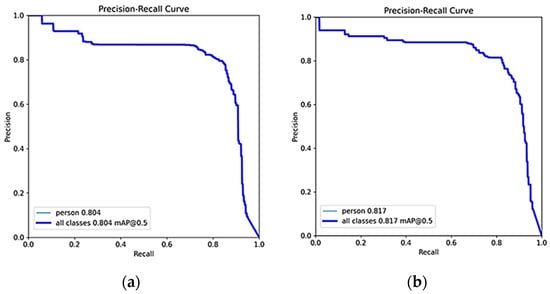
Figure 7.
P–R curves for freezing different layers of YOLOv5s-DbConv model based on heterogeneous hierarchical migration learning. (a) Original unfrozen network layer and (b) Freeze layer 0.
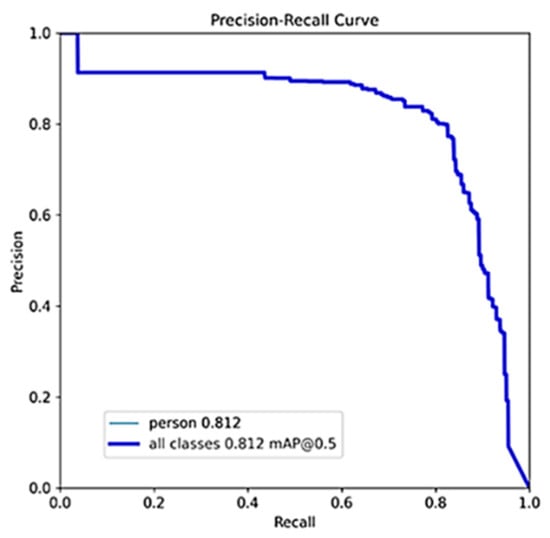
Figure 8.
P–R plot of ShuffleNetv2-YOLOv5s-DbConv algorithm based on heterogeneous hierarchical migration learning freezing layer 0.
The described method involves heterogeneous hierarchical migration learning, initially migrating source domain dataset weight parameters to the target network model and freezing layer 0 network module weight parameters. Subsequently, a retraining fine-tuning strategy is employed using the target domain dataset to detect the images with false detections in Figure 9b. The comparison of detection results is illustrated in Figure 9a, where Figure 9b highlights the presence of false detections, and Figure 9 demonstrates the effect of freezing the weight parameters of the first layer network module. This training strategy effectively reduces false detections in the background when detecting underwater rescue target acoustic images.
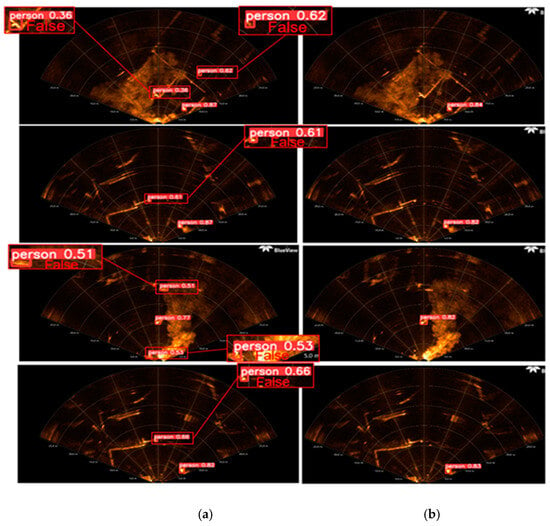
Figure 9.
Comparison of the detection effect of the proposed method on the complex background of underwater acoustics. (a) False detection and (b) Correct detection.
The training of the Db-ShuffleNetv2-YOLOv5s model, using heterogeneous hierarchical transfer learning with a frozen layer 0 network module, involves 300 epochs with a learning rate of 0.01 and an SGD optimizer for network gradient updates. To assess the detection performance of our algorithms on underwater rescue target acoustic image datasets, we compare them with commonly used YOLOv3 and SSD target detection algorithms, as well as the YOLOv5s model trained with official pre-training weights as the source domain. The comparative results under the same experimental settings are summarized in Table 6. It is evident that our proposed method in this paper outperforms other models in terms of mAP for underwater rescue target detection in acoustic images.

Table 6.
The comparative results.
3.5. Ablation Experiments
We compared the metrics mAP, GFLOPs, and Parameters for four cases: original YOLOv5s, Db-YOLOv5s, ShuffleNetv2-YOLOv5s, and Db-ShuffleNetv2-YOLOv5s, using YOLOv5s as the base model. The results are summarized in Table 7.

Table 7.
Comparison of the effects of different methods.
According to Table 7, the Db-YOLOv5s model achieves the highest mAP. The lightweight Db-ShuffleNetv2-YOLOv5s improved model follows closely, with only a slight 0.05 mAP difference but with significantly better GFLOPs and parameter metrics compared to Db-YOLOv5s. The Db-ShuffleNetv2-YOLOv5s model also improves mAP compared to the ShuffleNetv2-YOLOv5s model, albeit with minor increases in GFLOPs and parameters. The lightweight ShuffleNetv2-YOLOv5s-DbConv improved model outperforms the original YOLOv5s network model in terms of mAP, GFLOPs, and parameters. Therefore, our proposed lightweight ShuffleNetv2-YOLOv5s-DbMConv model sacrifices a slight mAP accuracy for a significant reduction in GFLOPs and parameters.
4. Discussion
The main operation scene of our proposed underwater rescue target detection and recognition algorithm based on acoustic images is single rescue target detection in complex scenes, and the rescue target is in the underwater suspension state. However, in an actual underwater rescue situation, there are multiple rescue targets and the rescue target is sinking. In future research, more attention should be given to the detection in this case, including the addition of 3D detection. The hierarchical transfer learning method of heterogeneous information based on model transfer proposed in this paper needs to train the SAR data set and the optical small target data set in the source domain and the underwater acoustic rescue target data set in the target domain, respectively, during training, which will consume more time. In subsequent research, we will further optimize the training strategy to reduce the training time.
5. Conclusions
This paper introduces an innovative framework for the underwater rescue target detection and recognition in acoustic images, tailored to address the unique challenges of complex underwater rescue scenarios. To enhance the detection accuracy, a hierarchical migration learning method is proposed, leveraging enhanced YOLOv5s with heterogeneous information. This approach significantly boosts accuracy by leveraging cross-similar features from SAR images, optically small target human images, and underwater acoustic rescue target images, addressing issues related to small dataset sizes and cross-domain adaptability. To optimize for the real-time deployment on resource-constrained devices, a two-branch convolutional module combined with ShuffleNetv2 is introduced, reducing computational requirements and model parameters, while maintaining detection accuracy. Freeze-and-train strategies are employed to further improve the detection accuracy in complex underwater settings. Comparative experiments on underwater acoustic tires and underwater acoustic rescue target datasets demonstrate the method’s ability to correctly identify these types of underwater acoustic small targets, outperforming traditional detection methods. Overall, this work represents a significant step forward in underwater rescue target detection, promising to improve the safety and efficiency of underwater rescue operations in real-world scenarios.
Author Contributions
Conceptualization, S.H.; methodology, S.H. and T.L.; software, T.L.; writing—original draft preparation, T.L.; writing—review and editing, S.H. All authors have read and agreed to the published version of the manuscript.
Funding
This research was funded by the National Natural Science Foundation of China under grant 51979057, 52131101, 52025111, China.
Institutional Review Board Statement
Not applicable.
Informed Consent Statement
Not applicable.
Data Availability Statement
The data presented in this study are available on request from the corresponding author.
Conflicts of Interest
The authors declare no conflicts of interest.
References
- Celik, T.; Tjahjadi, T. A novel method for sidescan sonar image segmentation. IEEE J. Ocean. Eng. 2011, 36, 186–194. [Google Scholar] [CrossRef]
- Reed, S.; Petillot, Y.; Bell, J. An automatic approach to the detection and extraction of mine features in sidescan sonar. IEEE J. Ocean. Eng. 2003, 28, 90–105. [Google Scholar] [CrossRef]
- Abdullah; Hasan, M.S. An application of pre-trained CNN for image classification. In Proceedings of the 2017 20th International Conference of Computer and Information Technology (ICCIT), Dhaka, Bangladesh, 22–24 December 2017; IEEE: Piscataway, NJ, USA, 2017. [Google Scholar]
- Valdenegro-Toro, M. Object recognition in forward-looking sonar images with convolutional neural networks. In Proceedings of the OCEANS 2016 MTS/IEEE Monterey, Monterey, CA, USA, 19–23 September 2016; IEEE: Piscataway, NJ, USA, 2016. [Google Scholar]
- McKay, J.; Gerg, I.; Monga, V.; Raj, R.G. What’s mine is yours: Pretrained CNNs for limited training sonar ATR. In Proceedings of the OCEANS 2017-Anchorage, Anchorage, AK, USA, 18–21 September 2017; IEEE: Piscataway, NJ, USA, 2017. [Google Scholar]
- Ye, X.; Li, C.; Zhang, S.; Yang, P.; Li, X. Research on side-scan sonar image target classification method based on transfer learning. In Proceedings of the OCEANS 2018 MTS/IEEE Charleston, Charleston, SC, USA, 22–25 October 2018; IEEE: Piscataway, NJ, USA, 2018. [Google Scholar]
- Qin, X.; Luo, X.; Wu, Z.; Shang, J. Optimizing the sediment classification of small side-scan sonar images based on deep learning. IEEE Access 2021, 9, 29416–29428. [Google Scholar] [CrossRef]
- Gerg, I.D.; Monga, V. Structural prior driven regularized deep learning for sonar image classification. IEEE Trans. Geosci. Remote Sens. 2021, 60, 4200416. [Google Scholar] [CrossRef]
- Zhang, P.; Tang, J.; Zhong, H.; Ning, M.; Liu, D.; Wu, K. Self-trained target detection of radar and sonar images using automatic deep learning. IEEE Trans. Geosci. Remote Sens. 2021, 60, 4701914. [Google Scholar] [CrossRef]
- Inoue, H. Data augmentation by pairing samples for images classification. arXiv 2018, arXiv:1801.02929. [Google Scholar]
- Wang, Z.; Chen, H.; Qin, H.; Chen, Q. Self-Supervised Pre-Training Joint Framework: Assisting Lightweight Detection Network for Underwater Object Detection. J. Mar. Sci. Eng. 2023, 11, 604. [Google Scholar] [CrossRef]
- Barngrover, C.; Kastner, R.; Belongie, S. Semisynthetic versus real-world sonar training data for the classification of mine-like objects. IEEE J. Ocean. Eng. 2014, 40, 48–56. [Google Scholar] [CrossRef][Green Version]
- Ge, Q.; Ruan, F.; Qiao, B.; Zhang, Q.; Zuo, X.; Dang, L. Side-scan sonar image classification based on style transfer and pre-trained convolutional neural networks. Electronics 2021, 10, 1823. [Google Scholar] [CrossRef]
- Li, C.; Ye, X.; Cao, D.; Hou, J.; Yang, H. Zero shot objects classification method of side scan sonar image based on synthesis of pseudo samples. Appl. Acoust. 2021, 173, 107691. [Google Scholar] [CrossRef]
- Simonyan, K.; Zisserman, A. Very deep convolutional networks for large-scale image recognition. arXiv 2014, arXiv:1409.1556. [Google Scholar]
- Huo, G.; Wu, Z.; Li, J. Underwater object classification in sidescan sonar images using deep transfer learning and semisynthetic training data. IEEE Access 2020, 8, 47407–47418. [Google Scholar] [CrossRef]
- Chen, H.; Yuan, H.; Qin, H.; Mu, X. Underwater Drowning People Detection Based On Bottleneck Transformer And Feature Pyramid Network. In Proceedings of the 2022 IEEE International Conference on Unmanned Systems (ICUS), Guangzhou, China, 28–30 October 2022; pp. 1145–1150. [Google Scholar] [CrossRef]
- Li, Y.; Ye, X.; Zhang, W. TransYOLO: High-Performance Object Detector for Forward Looking Sonar Images. IEEE Signal Process. Lett. 2022, 29, 2098–2102. [Google Scholar] [CrossRef]
- Cheng, Z.; Huo, G.; Li, H. A multi-domain collaborative transfer learning method with multi-scale repeated attention mechanism for underwater side-scan sonar image classification. Remote Sens. 2022, 14, 355. [Google Scholar] [CrossRef]
- Wang, J.; Feng, C.; Wang, L.; Li, G.; He, B. Detection of Weak and Small Targets in Forward-Looking Sonar Image Using Multi-Branch Shuttle Neural Network. IEEE Sens. J. 2022, 22, 6772–6783. [Google Scholar] [CrossRef]
- Yu, X.; Gong, Y.; Jiang, N.; Ye, Q.; Han, Z. Scale match for tiny person detection. In Proceedings of the IEEE/CVF Winter Conference on Applications of Computer Vision, Village, CO, USA, 1–5 March 2020. [Google Scholar]
- Ma, N.; Zhang, X.; Zheng, H.-T.; Sun, J. Shufflenet v2: Practical guidelines for efficient cnn architecture design. In Proceedings of the European Conference on Computer Vision (ECCV), Munich, Germany, 8–14 September 2018. [Google Scholar]
- Chen, Z.; Yang, J.; Chen, L.; Jiao, H. Garbage classification system based on improved ShuffleNet v2. Resour. Conserv. Recycl. 2022, 178, 106090. [Google Scholar] [CrossRef]
- Ghosh, S.; Mondal, J.; Sen, S.; Chatterjee, S.; Roy, N.K.; Patnaik, S. A novel approach to detect and classify fruits using ShuffleNet V2. In Proceedings of the 2020 IEEE Applied Signal Processing Conference (ASPCON), Kolkata, India, 7–9 October 2020; IEEE: Piscataway, NJ, USA, 2020. [Google Scholar]
- Yang, R.; Lu, X.; Huang, J.; Zhou, J.; Jiao, J.; Liu, Y.; Liu, F.; Su, B.; Gu, P. A multi-source data fusion decision-making method for disease and pest detection of grape foliage based on ShuffleNet V2. Remote Sens. 2021, 13, 5102. [Google Scholar] [CrossRef]
- He, K.; Zhang, X.; Ren, S.; Sun, J. Deep residual learning for image recognition. In Proceedings of the IEEE Conference on Computer Vision and Pattern Recognition, Las Vegas, NV, USA, 27–30 June 2016. [Google Scholar]
Disclaimer/Publisher’s Note: The statements, opinions and data contained in all publications are solely those of the individual author(s) and contributor(s) and not of MDPI and/or the editor(s). MDPI and/or the editor(s) disclaim responsibility for any injury to people or property resulting from any ideas, methods, instructions or products referred to in the content. |
© 2024 by the authors. Licensee MDPI, Basel, Switzerland. This article is an open access article distributed under the terms and conditions of the Creative Commons Attribution (CC BY) license (https://creativecommons.org/licenses/by/4.0/).